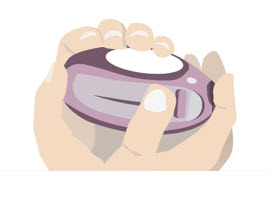How do I properly use my dry inhaler?
This article was reviewed by Senior Director of Community Engagement and COPD360social Community Manager, Bill Clark, as well as certified staff Respiratory Therapists on January 29, 2020.

Dear Coach,
I just finished a pulmonary rehabilitation class and noticed today that my incidence of shortness of breath had decreased. However, I am still having trouble inhaling my new dry powder long acting inhaler. Everyone teaches pursed lip breathing, but what exercises will help with taking deep breaths through my mouth? I feel like I do not get the dry powder into my lungs and it only stays in my mouth.
Powder Puff
Dear Powder Puff,
As COPD progresses it is often difficult to take deep breaths. While it may seem counter-intuitive, COPD is actually a disease that limits your output of air, not taking it in. Until you can successfully empty your lungs, you will not be able to take as much air in; kind of like you can only fill a glass so far. Pursed lip breathing does help empty your lungs and it also helps rid you of excessive CO2 buildup. I also do a modified version of pursed lip breathing where I take a large breath through my mouth and slowly try emptying my lungs as much as possible. At first, I find I can only exhale a small volume but with continued tries I find I am progressively taking deeper breaths. I do this several times a day. This may not work with everyone because it would be dependent on how severe your disease process is; also, because of hyper-inflation of the lungs the breathing muscles aren't nearly as effective as they could be.
As for dry powder inhalers; they can be problematic for many as they just don't have enough lung function to get the powder where it needs to be. What I find that works for me is: first I do the open mouth breathing exercise or pursed lip breathing first and then instead of holding my mouth tightly around the inhaler, I hold my mouth a little looser around the mouth piece and "huff" in the medication then follow by immediately taking as many follow-up huffs as I am able before taking in another breath. I want to stress that there is no scientific evidence to prove that this works but I can say it works for me.
Another thing I have tried that is effective (and recommended by my doctor) is I use a bi-pap set to high settings (also recommended by my doctor) 20 minutes in the morning and twenty minutes before bed before using my dry powder inhalers. Interestingly enough, I had a problem with waking up during the night feeling out of breath and this pretty much solved it and I generally felt like I was able to take deeper breaths afterwards.
Ultimately, if you don’t ‘feel’ like the medicine is making it into your lungs, it may not be. Talk to your doctor and see if he is able to order a test to check your inspiratory flow. They can do this pretty easily with a tool that is called an Incheck dial. This tool can measure whether you have enough force to draw the medicine into your lungs. Every dry powder inhaler requires a different amount of force to draw out the medicine. If you aren’t generating enough force, the medicine will not be effective, so your doctor may want to prescribe a medicine that you can use in your nebulizer. These medicines are expensive, so find a delivery system that works for you so the medicine can help keep your exacerbations at bay.
Hope this helps,
The COPD Coach
Coaches Corner is aimed at providing information for individuals with COPD to take to your doctor, and is not in any way intended to be medical advice. If you would like to submit a question to the Coaches Corner email us at coachescorner@copdfoundation.org. We would love to hear your questions and comments. You can address your emails to The COPD Coach.